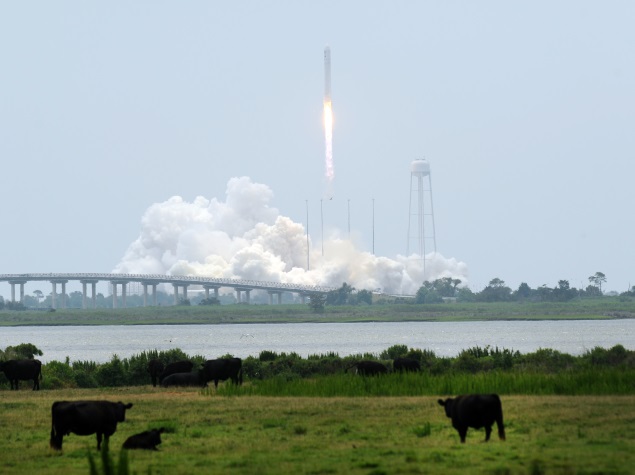- Home
- Science
- Science News
- SpaceX Launches Falcon Rocket With Commercial Satellite After Hitch
SpaceX Launches Falcon Rocket With Commercial Satellite After Hitch

On its second launch attempt of the day, the 224-foot (68-meter) rocket lifted off at 4 a.m. EDT/0800 GMT, blazing through partly cloudy, pre-dawn skies as it headed into space.
The first try, 2-1/2 hours earlier, ended less than a minute before liftoff when a computer found a potential problem with the rocket's first-stage engine, SpaceX officials said in a live webcast. The issue was resolved, clearing the rocket for flight.
Perched on top of the Falcon 9 was a communications satellite owned by Hong Kong-based Asia Satellite Telecommunications Holdings Ltd, or AsiaSat.
The spacecraft, known as AsiaSat 8 and built by Space Systems/Loral, a Palo Alto, Calif.-based subsidiary of Canada's MacDonald Dettwiler and Associates Ltd, will become the fifth member of an orbital network that provides telecommunication services to the Asia-Pacific region.
AsiaSat hired privately owned SpaceX for two satellite launches, the second of which is due to launch later this month.
Previously, AsiaSat bought rides on Russian Proton rockets but decided to hire SpaceX after the California-based start-up won a Nasa contract to fly cargo to the International Space Station, AsiaSat chief executive William Wade said in a pre-launch interview.
"We gained confidence in seeing how they were developing technically," Wade said.
AsiaSat had not used a U.S. launcher since 2003.SpaceX's cut-rate launch price - rides on Falcon 9 were selling for about $54 million at the time - also was a factor, he said.
SpaceX's website shows the price of a Falcon 9 is now $61.2 million. The company, owned and operated by technology entrepreneur Elon Musk, has a backlog of nearly 40 missions.
Tuesday's launch was the SpaceX's second in three weeks. The company's last launch was delayed by a series of technical issues, which then bumped AsiaSat's launch.
"We're a few months later than we would liked to have been launched. That's not totally unexpected with a new launch provider. There are some growing pains and some teething that goes on with a new supplier," Wade said.
Once in orbit about 22,300 miles (35,888 km) over Asia, the new satellite, which is equipped with 24 Ku-band transponders and a Ka-band beam, will relay digital television, broadband and other telecommunications services for customers in India, China, Southeast Asia and the Middle East.
Including satellite construction, launch and insurance, the mission is costing AsiaSat between $180 million and $200 million, Wade said.
The satellite is designed to last for 15 years.
© Thomson Reuters 2014
For the latest tech news and reviews, follow Gadgets 360 on X, Facebook, WhatsApp, Threads and Google News. For the latest videos on gadgets and tech, subscribe to our YouTube channel. If you want to know everything about top influencers, follow our in-house Who'sThat360 on Instagram and YouTube.
- AI
- iPhone 16 Leaks
- Apple Vision Pro
- Oneplus 12
- iPhone 14
- Apple iPhone 15
- OnePlus Nord CE 3 Lite 5G
- iPhone 13
- Xiaomi 14 Pro
- Oppo Find N3
- Tecno Spark Go (2023)
- Realme V30
- Best Phones Under 25000
- Samsung Galaxy S24 Series
- Cryptocurrency
- iQoo 12
- Samsung Galaxy S24 Ultra
- Giottus
- Samsung Galaxy Z Flip 5
- Apple 'Scary Fast'
- Housefull 5
- GoPro Hero 12 Black Review
- Invincible Season 2
- JioGlass
- HD Ready TV
- Laptop Under 50000
- Smartwatch Under 10000
- Latest Mobile Phones
- Compare Phones
- HMD Pulse
- HMD Pulse+
- HMD Pulse Pro
- Realme Narzo 70x 5G
- Realme Narzo 70 5G
- Samsung Galaxy C55
- Blackview Hero 10
- Oppo K12
- Lenovo IdeaPad Pro 5i
- Asus ZenBook Duo 2024 (UX8406)
- Realme Pad 2 Wi-Fi
- Redmi Pad Pro
- boAt Storm Call 3
- Lava ProWatch Zn
- Samsung Samsung Neo QLED 8K Smart TV QN800D
- Samsung Neo QLED 4K Smart TV (QN90D)
- Sony PlayStation 5 Slim Digital Edition
- Sony PlayStation 5 Slim
- Lloyd 1.5 Ton 3 Star Inverter Split AC (GLS18I3FOSEW)
- Haier 1.5 Ton 3 Star Triple Inverter Split AC (HSU18K-PYSS3BN-INV)












